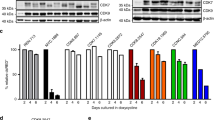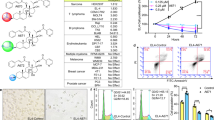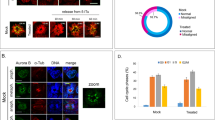Abstract
Dimethylsulfoxide (DMSO) was shown to inhibit the proliferation of several B cell lines including Raji, Daudi, and SKW6-CL4 but the mechanisms involved in this growth arrest are still unclear. We show that in 7TD1 mouse hybridoma cells a DMSO-induced reversible G1 arrest involves inactivation of Rb kinases, cyclin D2/CDK4 and cyclin E/CDK2. This occurs by at least three distinct mechanisms. Inhibition of cyclin D2 neosynthesis leads to a dramatic decrease of cyclinD2/CDK4 complexes. This in turn enables the redistribution of p27[KIP1] from cyclin D2/CDK4 to cyclin E/CDK2 complexes. In addition, the simultaneous accumulation of p21[CIP1] entails increasing association with cyclin D3/CDK4 and cyclin E/CDK2. Thus, p21[CIP1] and p27[KIP1], act in concert to inhibit cyclin E/CDK2 activity which, together with CDK4 inactivation, confers a G1-phase arrest.
This is a preview of subscription content, access via your institution
Access options
Subscribe to this journal
Receive 50 print issues and online access
$259.00 per year
only $5.18 per issue
Buy this article
- Purchase on Springer Link
- Instant access to full article PDF
Prices may be subject to local taxes which are calculated during checkout
Similar content being viewed by others
Author information
Authors and Affiliations
Rights and permissions
About this article
Cite this article
Ponzio, G., Loubat, A., Rochet, N. et al. Early G1 growth arrest of hybridoma B cells by DMSO involves cyclin D2 inhibition and p21[CIP1] induction. Oncogene 17, 1159–1166 (1998). https://doi.org/10.1038/sj.onc.1202040
Received:
Revised:
Accepted:
Published:
Issue Date:
DOI: https://doi.org/10.1038/sj.onc.1202040
Keywords
This article is cited by
-
MiR-17 and miR-19 cooperatively promote skeletal muscle cell differentiation
Cellular and Molecular Life Sciences (2019)
-
Berberine regulates the protein expression of multiple tumorigenesis-related genes in hepatocellular carcinoma cell lines
Cancer Cell International (2017)
-
Dimethylsulfoxide excerbates cisplatin-induced cytotoxicity in Ehrlich ascites carcinoma cells
Cancer Cell International (2015)
-
A simple tool to improve pluripotent stem cell differentiation
Nature Methods (2013)
-
Proliferation control strategies to improve productivity and survival during CHO based production culture
Cytotechnology (2007)



